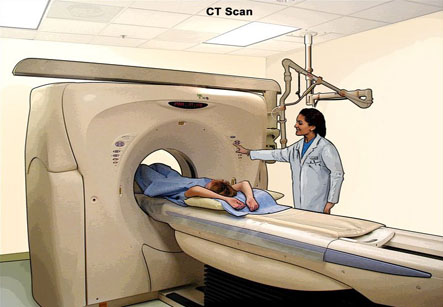Computed Tomography CT Scan
Introduction
A computed tomography (CT) scan is an imaging study that uses x-rays to create cross-sectional pictures of the body.
Procedure:
Patient is asked to lie on a narrow table that slides into the center of the CT scanner machine.
Once the patient is inside the scanner, the machine’s x-ray beam rotates around the body. (Modern “spiral” scanners can perform the exam without stopping.)
Computer software creates separate images of the targeted body area, called slices. These images can be stored, viewed on a monitor, or printed on film. Three-dimensional models of the body area can be created by arranging the slices together.
Patient must be very still during the exam, as movement causes blurring of images. Patient may be told to hold the breath for short periods of time.
Generally, complete scans take only a few minutes. The modern scanners can image the entire body, from head to toe, in less than 30 seconds.
Iran has made significant progress in neurosurgery and The world renowned Iranian scientist in neurological surgery Professor Majid Samii has garnered the 2014 Golden Neuron Award. We have all the information you need about public and private clinics and hospitals that provide Neurosurgical surgeries in Iran, Islamic Republic Of with the best quality and lowest possible price

Preparation:
Certain CT exams require a special dye, called as contrast. This dye needs to be delivered into the body before the test starts. Contrast helps certain areas show up better on the scans.
The doctor should be informed if you have ever had a reaction to contrast. Patient may need to take medications before the test in order to safely receive this substance.
If contrast absolutely needs to be given, the doctor may give antihistamines or steroids before the test.
Contrast can be given several ways which depends on the type of CT being performed.
It may be delivered through a vein (IV) in the hand or forearm.
It may be given through the rectum using an enema. The contrast can be given to drink before the scan. The time to drink the contrast depends on the type of exam being done. The contrast liquid may taste chalky, although some may be flavored to make it taste a little better. The contrast eventually passes out of the body through the urine.
If contrast is used, patient may also be asked not to eat or drink anything for 4-6 hours before the test.
Before receiving the contrast, the doctor should be informed if a diabetes medication called as metformin is being taken as extra precautions are needed in that case.
If weight of the patient is more than 300 pounds, it can cause damage to the scanner’s working parts in some machines.
Patient is asked to remove any jewelry and change into a hospital gown during the study.
Some people may have discomfort from lying on the hard table.
Contrast given through an IV may cause a slight burning sensation, a metallic taste in the mouth, and a warm flushing of the body. These sensations are considered normal and usually go away within a few seconds.
Indications:
CT rapidly creates detailed pictures of the body, including the brain, chest, spine, and abdomen. The test may be used to:
• Diagnose an infection
• Identify masses, tumors, and cancerous growths
• Guide a surgeon to locate the right area during a biopsy
• Study blood vessels by angiogram
Risks of CT scans include:
Exposure to radiation – CT scans expose the patient to more amount of radiation than regular x-rays. Having many x-rays or CT scans over time can increase the risk for cancer. However, the risk from any one scan is small. This risk should be weighed against the benefits of getting a correct diagnosis for a medical problem.
Allergies to contrast dye – Some people have allergies to contrast dye. It should be informed to the doctor if you have ever had an allergic reaction to injected contrast dye.
The most common type of contrast given into intravenously contains iodine. If a person with an iodine allergy is given this type of contrast, nausea or vomiting, sneezing, itching, or hives can occur.
If contrast absolutely needs to be given, the doctor may give antihistamines or steroids before the test.
The kidneys help to remove iodine out of the body. Those patients with kidney disease or diabetes may need to receive extra fluids after the test to help flush the iodine out of their body.
Rarely, the dye may cause a life-threatening allergic response called as anaphylaxis. If patient feels having any trouble in breathing during the test, it should be notified to the scanner operator immediately. Scanners come with a facility of an intercom and speakers, so the operator can hear the patient at all times.